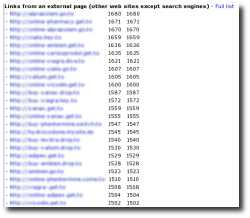
PDF‘s, text files, HTML‘s and
directories in the KDE Desktop with previews (click to enlarge)
 ERTAIN issues arise when habits and user orientation in his/her desktop are interfered with. Desktop environments, installers, filesystem structures, or even platforms in general are often more workable and thus successful if they comply with the expectation of new users. What if these are made too stringent by the developers, however? What if decisions and conventions are voted for without involvement of the end-user?
ERTAIN issues arise when habits and user orientation in his/her desktop are interfered with. Desktop environments, installers, filesystem structures, or even platforms in general are often more workable and thus successful if they comply with the expectation of new users. What if these are made too stringent by the developers, however? What if decisions and conventions are voted for without involvement of the end-user?
Many desktop environments, free ones in particular, are not made uniform. The resulting diversity and flexibility leads to difficulties in using somebody else’s settings, i.e. working in conjunction under the same session. Some GNU/Linux distributions include more or less any desktop environment which exists while settings are kept apart and well-separable for each user of the system and each desktop environment. So, where does the the problem lie? Give users more freedom, I suggest, and make that the norm. It is, after all, their own computer and they understand their needs better than the developers of the operating system.
What appears worse than all is the scenario where decisions are arrogantly by the vendor and then enforced. This is often the path that operating systems such as Mac O/S (to its varieties) and Windows do. Give the user some more choice, I say, by adding options for endless customisation that has very few boundaries, if any (Open Source). Give all users the freedom they deserve and allow them to express individuality and adapt/tailor their desktop environment to suit their needs. Menu entries and other widgets will remain unaffected, so documentation, for instance, will not suffer as a consequence.
People work differently on a variety of applications, for a wide variety of purposes. The domains in which they work differ as well. A person working with many open windows at any given time might prefer to have “focus follows mouse cursor”. Contrariwise, to some, this “focus follows mouse cursor” behaviour is highly adverse to habits. To list yet another example, a Web server needs to have a light desktop environment that is less susceptible to breakage and consumes small amounts of RAM.
These considerations are all highly defensible. If Linux was to be deployed in more public clusters, for example, choice could (and should) be given as to which desktop environment should be used. Different strokes for different folks, but all can be catered for provided that disk space is made available. The pertinent settings would reside in the home directory of each user. Thumbs up to Gnome, KDE, and the rest of the self-motivated window manager teams around the world.
Related item: KDE Versus GNOME
 Only weeks after Massachusetts decided to ditch Microsoft Office, Open Office 2 is officially announced and released to the public. This version of Open Office has been claimed by some to be faster and superior to Microsoft Office. Most importantly, it adheres to OASIS, it is inter-operable, and free.
Only weeks after Massachusetts decided to ditch Microsoft Office, Open Office 2 is officially announced and released to the public. This version of Open Office has been claimed by some to be faster and superior to Microsoft Office. Most importantly, it adheres to OASIS, it is inter-operable, and free.





 Filed under:
Filed under: 
 INDOWS Vista was already said to be a trainwreck, primarily due to its inability to deliver something innovative. It gives no compelling reason whatsoever for users to upgrade. People who have had the chance to fiddle with the Vista beta build can confirm this. In fact, it seems to be lagging behind other operating systems, notably Mac OS X as was previously
INDOWS Vista was already said to be a trainwreck, primarily due to its inability to deliver something innovative. It gives no compelling reason whatsoever for users to upgrade. People who have had the chance to fiddle with the Vista beta build can confirm this. In fact, it seems to be lagging behind other operating systems, notably Mac OS X as was previously 
 little tour around Google has led me to a questionably out-of-date
little tour around Google has led me to a questionably out-of-date 
 OHN H. Terpstra, a bold IT consultant, explains in an excellent article, which comes in 3 parts, how Microsoft and its disguised allies are
OHN H. Terpstra, a bold IT consultant, explains in an excellent article, which comes in 3 parts, how Microsoft and its disguised allies are 
 OXTRAPPERS are a mechanism for stopping large volumes of E-mail spam. The key idea is relatively simple as the following paragraph explains.
OXTRAPPERS are a mechanism for stopping large volumes of E-mail spam. The key idea is relatively simple as the following paragraph explains.
 ERTAIN issues arise when habits and user orientation in his/her desktop are interfered with. Desktop environments, installers, filesystem structures, or even platforms in general are often more workable and thus successful if they comply with the expectation of new users. What if these are made too stringent by the developers, however? What if decisions and conventions are voted for without involvement of the end-user?
ERTAIN issues arise when habits and user orientation in his/her desktop are interfered with. Desktop environments, installers, filesystem structures, or even platforms in general are often more workable and thus successful if they comply with the expectation of new users. What if these are made too stringent by the developers, however? What if decisions and conventions are voted for without involvement of the end-user?
 OME decent-scale DoS attacks, carried out by hijacked Windows workstations, have returned to the site. This comes after
OME decent-scale DoS attacks, carried out by hijacked Windows workstations, have returned to the site. This comes after